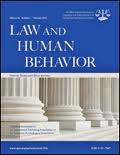 The current study examined the influence of pretrial publicity on mock-jurors’ guilt decisions, perceptions of the defendant, memories, and evidence interpretation and found that pretrial publicity can bias jurors’ interpretations and that deliberations can result in the transfer of bias from tainted to untainted jurors. This is the bottom line of a recently published article in Law and Human Behavior. Below is a summary of the research and findings as well as a translation of this research into practice.
The current study examined the influence of pretrial publicity on mock-jurors’ guilt decisions, perceptions of the defendant, memories, and evidence interpretation and found that pretrial publicity can bias jurors’ interpretations and that deliberations can result in the transfer of bias from tainted to untainted jurors. This is the bottom line of a recently published article in Law and Human Behavior. Below is a summary of the research and findings as well as a translation of this research into practice.

Featured Article | Law and Human Behavior | 2017, Vol. 41, No. 5, 478-493
Keep Your Bias to Yourself: How Deliberating With Differently Biased Others Affects Mock-Jurors’ Guilt Decisions, Perceptions of the Defendant, Memories, and Evidence Interpretation
Authors
Christine L. Ruva, University of South Florida Sarasota-Manatee
Christina C. Guenther, University of South Florida
Abstract
This experiment explored how mock-jurors’ (N 648) guilt decisions, perceptions of the defendant, memories, and evidence interpretation varied as a function of jury type and pretrial publicity (PTP); utilizing a 2 (jury type: pure-PTP vs. mixed-PTP) 3 (PTP: defendant, victim, and irrelevant) factorial design. Mock-juries (N 126) were composed of jurors exposed to the same type of PTP (pure-PTP; e.g., defendant-PTP) or different types of PTP (mixed-PTP; e.g., half exposed to defendant-PTP and half to irrelevant-PTP). Before deliberations jurors exposed to defendant-PTP were most likely to vote guilty; while those exposed to victim-PTP were least likely. After deliberations, jury type and PTP affected jurors’ guilt decisions. Specifically, jurors deliberating on pure-PTP juries had verdict distributions that closely resembled the predeliberation distributions. The verdict distributions of jurors on mixed-PTP juries suggested that jurors were influenced by those they deliberated with. Jurors not exposed to PTP appeared to incorporate bias from PTP-exposed jurors. Only PTP had significant effects on postdeliberation measures of memory and evidence interpretation. Mediation analyses revealed that evidence interpretation and defendant credibility assessments mediated the effect of PTP on guilt ratings. Taken together these findings suggest that during deliberations PTP bias can spread to jurors not previously exposed to PTP. In addition, juries composed of jurors exposed to different PTP slants, as opposed to a single PTP slant, can result in less biased decisions. Finally, deliberating with others who do not share similar biases may have little, if any, impact on biased evidence interpretation or memory errors.
Keywords
juror decision making, jury deliberation, pretrial publicity, memory, evidence interpretation
Summary of the Research
“Much literature exists related to the biasing effects of pretrial publicity (PTP) on individual juror guilt decisions, but less is known about how PTP influences the jury deliberation process and ultimately jury verdicts. Most research on the jury deliberation process examines juries composed of jurors exposed to the same type of PTP (pure exposure), and does not consider how jurors exposed to different types of PTP (mixed exposure) would affect the deliberation process and the transfer of PTP bias. That being said, PTP has been found to impart its bias on jurors’ decisions by influencing their perceptions of defendants, their ability to discriminate the source of case information (PTP vs. Trial), and through predecisional distortion. The present study explores the effects of PTP and jury type (pure vs. mixed PTP exposure) on jurors’ guilt decisions, perceptions of the defendant, memories, and evidence interpretation; along with whether these variables are mechanisms through which PTP imparts its bias on jurors’ decisions. In addition, the study explores whether PTP exposed jurors will spread their bias to jurors not previously exposed to PTP during jury deliberations” (p. 478).
“Ample research suggests that PTP can bias a juror through a multitude of mechanisms. However, the legal assumption is that untainted jurors will correct tainted jurors by recognizing and rejecting incorrect information, thus balancing the biases of the individual jurors. This article begins by exploring several mechanisms found to be responsible for the influence of PTP on juror guilt decisions. It then explores whether jury deliberations are likely to reduce juror bias and memory errors, or provide an opportunity for PTP exposed jurors to bias jurors not previously exposed to PTP” (p. 478).
“Research has shown that PTP affects jurors’ perception of the defendant; with jurors exposed to negative defendant PTP viewing the defendant as less credible than those not exposed to PTP. In addition, perceptions of defendant credibility have mediated PTP’s effect on guilt measures. Therefore, negative defendant PTP results in jurors forming negative impressions of the defendant, which ultimately influences their verdicts. In addition to affecting the way jurors perceive the defendant, PTP has been found to influence jurors’ interpretation of trial evidence, which has been explained by both the story model and predecisional distortion theory” (p.478-479).
“According to Pennington and Hastie’s story model, jurors begin the decision-making process by constructing a mental representation comprised of information presented at trial; as well as information jurors bring to trial (e.g., PTP). These mental representations are then used as frameworks for interpreting subsequent trial evidence to create a coherent story. This theory suggests that jurors who have been exposed to PTP before trial might construct a story similar to the PTP, and/or use PTP to fill informational gaps that exist because of incomplete trial evidence. Thus, PTP may influence jurors’ decisions by biasing their interpretation of, and possibly memory for, evidence presented at trial. Consistent with this assumption, mock-juror’s evaluation of trial evidence during deliberations has been found to be influenced by PTP exposure, which can also be explained by predecisional distortion theory” (p. 479).
“Predecisional distortion theory posits that jurors might distort trial evidence to support their favored side (defense or prosecution), as opposed to weighing the evidence according to its probative value, resulting in biased decisions. Research shows that once jurors have chosen a side they are likely to distort future evidence in a manner supportive of their chosen side. In addition, it has been found that during deliberations jurors exposed to negative defendant PTP were more likely to discuss ambiguous trial evidence as supporting the prosecution’s case, when compared with those given irrelevant-PTP. These biased interpretations of trial evidence were found to mediate the effect of PTP on decisions” (p. 479).
Current Study
“The present study explores how juries made up of jurors exposed to different types of PTP differ from juries exposed to no PTP or only one type of PTP. This was accomplished by first exposing mock-jurors to one of three types of PTP: negative defendant (defendant-PTP), negative victim (victim-PTP), or irrelevant-PTP. Approximately 1 week after PTP exposure, mock-jurors viewed a trial involving a woman accused of murdering her husband. They then deliberated on juries consisting of 4 to 6 jurors, who were either all exposed to the same type of PTP (pure juries) or on mixed juries with approximately half of the jurors exposed to one type of PTP (e.g., defendant) and the other to a different type of PTP (victim or irrelevant). These mock-jurors completed a trial memory test before and after deliberations. Some jurors provided guilt assessments (verdicts and guilt ratings) before deliberation; while others did not. All other measures were completed postdeliberation. These measures were used to assess memory, verdicts and guilt ratings, defendant credibility, and trial facts. Participants included 648 college students recruited through the Psychology department’s participant pool. However, 154 participants were disqualified for failing to complete the trial phase of the study” (p. 481-481).
Results
Consistent with our hypotheses and previous research, PTP exposure influenced jurors’ decisions (predeliberation, group level, and postdeliberation), memories, perceptions of defendant credibility, and interpretations of trial evidence. PTP was found to influence jurors’ guilt decisions through biased evidence interpretation (predecisional distortion) and impression formation (defendant credibility), which is also consistent with previous research. PTP’s influence on postdeliberation murder verdicts and guilt ratings was similar to its influence on credibility and evidence interpretation. Specifically, exposure to victim-PTP resulted in a prodefense bias (i.e., greater likelihood of not guilty verdict, higher credibility ratings, and evidence interpretation in favor of the defense); whereas exposure to defendant-PTP resulted in an anti-defense bias (i.e., greater likelihood of guilty verdict, lower credibility ratings, and evidence interpretation in favor of the prosecution). Although PTP-exposed jurors interpreted trial evidence and defendant credibility in a biased manner, their predeliberation memory performance was superior to the no-PTP controls in some areas assessed. In retrospect, the superior memory performance of PTP-exposed jurors makes sense given their multiple exposures to general case information; whereas no-PTP controls had only one exposure. After deliberations, PTP no longer influenced accurate memory responses, which may be because of the irrelevant-PTP jurors’ having greater memory improvement than victim-PTP and defendant-PTP jurors. Consistent with past research, defendant-PTP jurors made significantly more CSMEs than irrelevant-PTP jurors, and deliberations did not result in an increase or a reduction in CSMEs. Finally, regardless of time measured, or the area of memory assessed, the differences among PTP conditions were small; with jurors in all PTP conditions demonstrating good memory for the trial evidence” (p. 487-489).
“In addition to the influence of PTP, the type of jury mattered for postdeliberation guilt assessments of murder (jury- and juror-level) and defendant credibility ratings. At the jury level, the mixed defendant-irrelevant juries had guilt assessments that closely resembled those of pure defendant-PTP juries; thus demonstrating an antidefendant bias. Consistent with the jury-level findings, the postdeliberation guilt ratings of irrelevant- PTP jurors, who deliberated with defendant-PTP jurors, closely resembled those of defendant-PTP jurors, and were higher than their pure irrelevant-PTP counterparts. These results suggest that in contrast to the legal assumption that deliberations are effective at correcting bias, deliberations provided an opportunity for the PTP-exposed jurors to spread their bias to jurors not previously exposed to PTP. When the original bias was antivictim, there was evidence of bias reduction for those deliberating on mixed juries—who were more likely to vote guilty (postdeliberation) and rate the defendant lower in credibility than their pure jury counterparts” (p. 490).
Translating Research into Practice
“Consistent with the story model and predecisional distortion theory, the present study found that PTP exposure resulted in jurors interpreting trial evidence in the direction favored by the PTP. The story model explains such biased evidence interpretation as resulting from the formation of mental representations, consisting of information presented at trial and brought to trial (e.g., PTP), which are used as frameworks within which subsequent trial evidence is interpreted. Similarly, predecisional distortion theory suggests that jurors distort trial evidence to support their favored side, influencing jurors’ interpretation of trial evidence and ultimately their decisions. These primacy effects are thought to occur at the time of encoding information and, therefore, should not be influenced by postencoding events (i.e., deliberations). In fact, we found that evidence interpretation was only influenced by PTP; hence deliberation does not guarantee appropriate evaluation of evidence” (p. 490).
“Deliberation also did not guarantee memory improvement or correction. Memory improvement was only found for jurors not exposed to PTP, and was small (5%). Regardless of time tested, defendant-PTP jurors had proportions of CSMEs that were significantly greater than the no-PTP controls. Consistent with the concept of the reversed suggestibility effect, PTP information is incorporated into jurors’ memory for the trial (story), and may work through the mechanism of source confusion. This misinformation (PTP) becomes part of the juror’s trial story and is difficult if not impossible to correct” (p. 490).
“Although deliberation did not significantly increase or reduce memory errors, it did result in the transfer of bias from tainted jurors (defendant-PTP exposed) to untainted jurors (no-PTP controls). While the methods used in this research do not allow for tracking of bias transfer, theory and past research provide some insight into how bias may have been transferred. For example, Ruva and associates suggest that discussion of PTP (misinformation) is likely during deliberations and typically goes uncorrected. Hirst et al. (2012) suggest that discussion of such misinformation (PTP) can result in dispositional changes that then influence verdict preferences. These changes can occur in absence of memory change. According to persuasive arguments theory, the transfer of bias during deliberations could also result from biased sampling of trial information—in which jurors spend more time discussing, and provide better arguments for, their favored side (e.g., prosecution for defendant-PTP jurors). Finally, because of predecisional distortion jurors exposed to defendant-PTP are likely to encode trial information in favor of the prosecution. Then during deliberations, and regardless of its true probative value, these jurors discuss trial evidence as supporting the prosecution” (p. 491).
“Social decision scheme (SDS) theory states that the quality of jury-level decisions is largely determined by the decision norm used (e.g., consensus or majority rule) and predeliberation verdict distributions. In cases with moderate conviction rates (as the one used in the present study) the SDS of majority rules is believed to be responsible for groups polarizing the biases held by a majority of their members. In the present study, there was little evidence of polarization for jurors deliberating on pure defendant-PTP or pure victim-PTP juries. This lack of an evident group polarization effect could be because of the following: (a) the percentage of predeliberation not guilty verdicts being at or near ceiling level for victim-PTP jurors (74%), (b) the predeliberation guilty verdict percentage being at or near ceiling level for defendant-PTP jurors (68%), and (c) the presence of hung juries (5% pure victim-PTP and 29% pure defendant-PTP). That being said, pure victim-PTP jurors did show some evidence of increased bias, with their percentage of predeliberation not guilty verdicts (74%) being lower than either their jury-level (81%) or postdeliberation juror-level (84%). An interesting find was that when victim-PTP jurors deliberated on mixed juries their postdeliberation individual verdicts suggest a reduction of bias (64% not guilty). Finally, the SDS of majority rules may be operating on mixed defendant-irrelevant juries, whose guilt assessments did not significantly differ from pure defendant-PTP juries. At postdeliberation these irrelevant-PTP jurors were more likely to vote guilty than their counterparts who deliberated on pure juries; suggesting either personal change or acquiescence predicted by SDS” (p. 491).
Other Interesting Tidbits for Researchers and Clinicians
“This study demonstrated that both antivictim and antidefendant PTP can have powerful effects on juror and jury decisions. In addition, the composition of jury bias can influence jury- and juror-level decisions. On a positive note, juries composed of jurors exposed to different PTP slants, as opposed to a single PTP slant, can result in decisions that are less bias. Unfortunately, this research also suggests that jurors who have not been exposed to PTP before trial may incorporate PTP bias by deliberating with those who have been exposed. These findings are important given that different media sources may provide different slants on the same high profile case, resulting in a jury pool consisting of jurors with differing pretrial biases. It is hoped that exploring the influences of PTP and jury compositions will provide the courts and social scientists with a better understanding of the role deliberations play on the impact of PTP bias” (p. 491).
“The current study is one of only two known by the authors to explore the effects of mixed-PTP exposure on jury decisions, and the only one to explore how mixed-PTP exposure effects juror memory and interpretation of trial evidence. Therefore, more research is needed. Future research should explore how more realistic time delays, between trial exposure and memory testing, impact deliberation effects on memory. These time delays should also be implemented to examine whether the bias transfer we found from defendant-PTP jurors to irrelevant-PTP jurors increases over time. Research should also explore the influence of PTP in mixed juries having clear majority biases. Finally, researchers should examine these PTP and jury type effects using different types of criminal cases” (p. 491).
Join the Discussion
As always, please join the discussion below if you have thoughts or comments to add!







